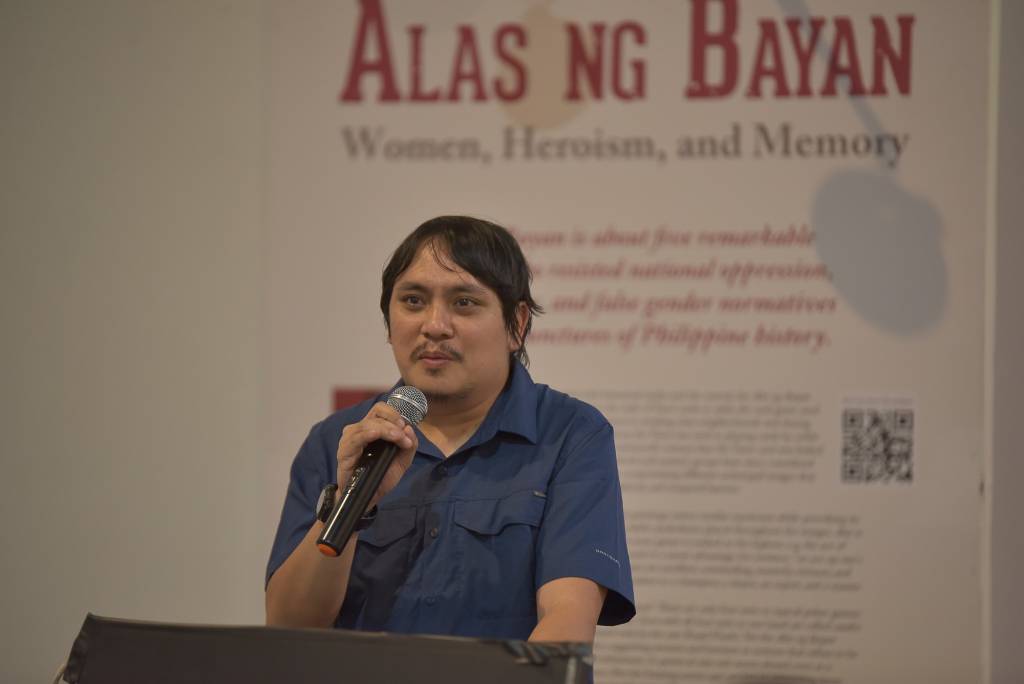We’ve been running the Alas ng Bayan: Women, History, and Memory exhibit in Manila for a while now. In paintings and lectures, we feature women who’ve struggled against injustice throughout Philippine history, to raise awareness about the intersections between feminism, historical memory, climate change, and citizenship.
I’ve found it so valuable to interact with the different people passing through, and to have the chance to engage in conversations on things that we usually take for granted. We’ve asked important questions about our relationship to the past and how our ways of living impact the environment. Who are today’s heroes, and how can we can we rise up to meet the challenge of our times?
During the last exhibit at De La Salle University, a curious student asked me why environmental and climate organizations would put on an exhibit like this, about women at the forefront of periods of struggle.
I gave my quick answer: environmental advocates should not only be concerned about the environment. We must also be committed feminists and good students of history, if we want to be loyal to our calling to protect this planet whom we call our mother.

Chuck Baclagon of 350 Pilipinas speaks during the opening exhibit of Alas ng Bayan at the College of Fine Arts, University of the Philippines – Diliman, which marks the second leg of the art works school tour for 2020. Photo: Institute for Climate and Sustainable Cities
The ecological crisis we’re experiencing now is a product of historical and material conditions. It’s borne out of social, political, cultural and economic systems that’ve led a powerful few who run industry and the state to maintain their privileges based off others’ work and subservience.
But history also points to a revolutionary force that has successfully challenged this hegemony of patriarchy: the loving, passionate, courageous and at times angry women who rose up to speak truth to power. Women who have played a big role in thwarting the domination of three empires, challenging a despotic tyrant, and facing off the forces of dirty energy development.
I believe that these artworks made by my friend Johnny Guarin show what it means to learn from the past. By capturing the lives and martyrdom of these women who resisted tyranny, we gain an idea of what heroism means and what new ways of being are possible.
But we must be aware: their lives are multi-dimensional and shaped by their respective contexts. We must also acknowledge our own subjectivity and recognize the need for nuance in retelling their tales. Not only is this imperative, here, or for art in general – but it’s essential in tackling the intersectional nature of the climate crisis, where society’s most vulnerable are already facing the worst impacts of climate change right now.
As climate activists, we must be astute students of history. To help us alter our course for the better and build on the painstaking work of those who have gone before, and to come up with new ways of seeing, doing, and being.
Because in the end, we all aim for a world that is not only socially just and ecologically sustainable – but one where we can defy stereotypes, defeat empires, exhibit beauty amid strife, serve the people, and sing our own songs.
May these paintings help us find connections and glimpses of our place in the struggle to shape history, grounded with beauty, solidarity, and shared humanity.
I’m grateful for the chance to take part in these ‘unfinished conversations’, and to all the people involved in carving out this space for art to shape our collective consciousness.
Thank you: to our friends from the Institute for Climate and Sustainable Cities and the Constantino Foundation, who organized the project and gave avenues for artists like Guarin to realize his vision. To the University of the Philippines College of Fine Arts for hosting us and providing a venue for this exhibition. To the families of Kumander Liwayway and Gloria Capitan who’ve been gracious enough to indulge us with their support and guiding presence. Lastly, to the friends and comrades at 350.org who in their own individual ways taught me to become a better person and a committed activist.